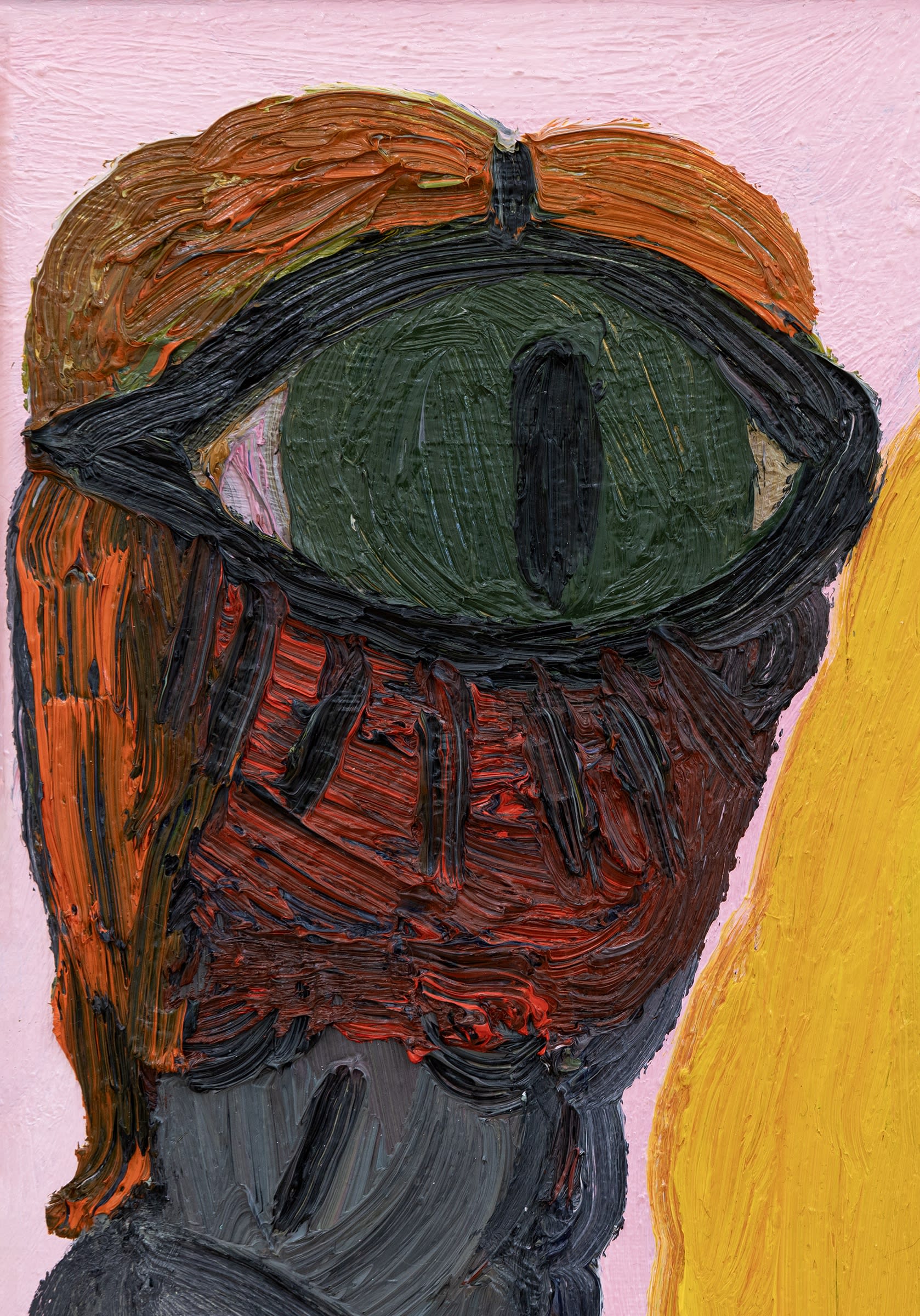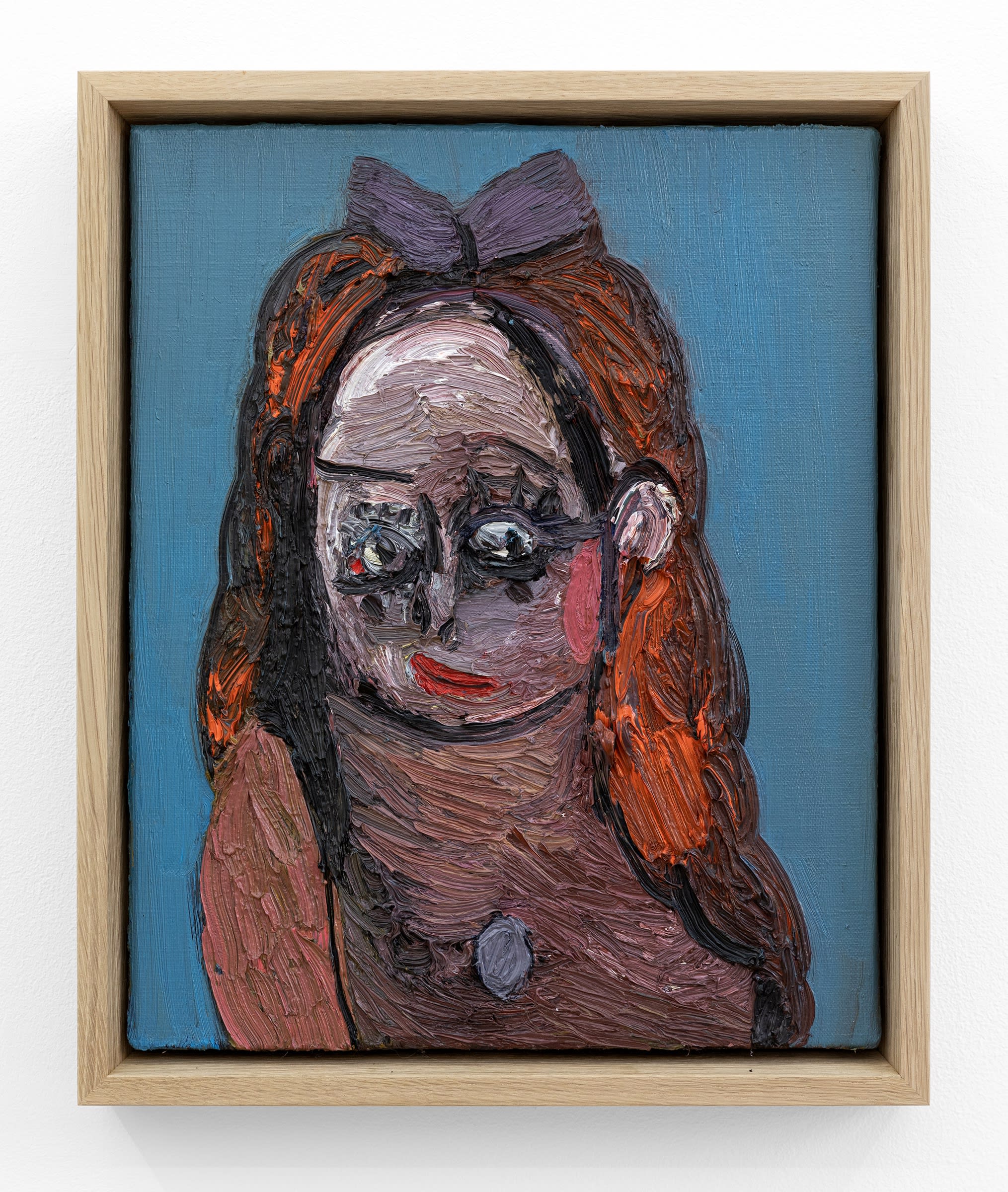 Studio Portrait of Trude Viken. Courtesy of the artist and OTP Copenhagen.
Studio Portrait of Trude Viken. Courtesy of the artist and OTP Copenhagen.
OTP: You often work in series of paintings, in this exhibition we encounter a series of new portraits as well as new ‘scenes.’ Could you tell me about the difference between the portraits and the scenes, and how they relate to each other?
TV: The difference between the portraits and the scenes mainly lies in how they convey emotions and perspectives. The portraits often represent the observers of the scenes, offering a more introspective and personal feeling. They are like quiet onlookers who witness what is going on. In another way the scenes are more narrative – focusing on the actions or situations taking place.
My scenes depict interactions and moods, often with more vibrant colors and complex compositions. The connection between them is that the portraits give the viewer insight into who is watching, allowing a deeper emotional bond to form.
OTP: Each of the scenes in this exhibition features three figures. Are there certain ideas relating to the dynamic between three that you have been thinking about?
TV: There is a unique tension or balance in compositions with three figures. Three is a number that represents a sense of imperfection or complexity. Two people can have a simple relationship, the introduction of a third person brings an element of conflict, harmony or balance – depending on the situation. Within this triad, new opportunities for interaction and dynamics emerge. It fascinates me that three people relationships often feel unstable.
 Trude Viken, The Warmth of Trust, The Chill of Distance, 2024, oil on canvas, 54.1 x 74.1 cm / 21.3 x 29.2 inches [framed in oak]. Courtesy of the artist and OTP Copenhagen.
Trude Viken, The Warmth of Trust, The Chill of Distance, 2024, oil on canvas, 54.1 x 74.1 cm / 21.3 x 29.2 inches [framed in oak]. Courtesy of the artist and OTP Copenhagen.
OTP: The pink backgrounds in these work heighten a certain sense of femininity. If we talk about facades, are you interested specifically in the facade that women present?
TV: My pink backgrounds certainly emphasise a sense of femininity, especially when paired with the clothes and hairstyles in the paintings. I am equally interested in what lies behind the facade of appearance that women often present, as well as with the facade itself. It can be about revealing or concealing something – beneath the surface is often a complexity of emotions, identity and experience.
OTP: Could I ask you to talk about eyes in these paintings and why you represent them in the way that you do?
TV: I find the eyes in my works are very important. For me they are windows to the soul and identity, but also foreground the idea of observation. By making the eyes large, and sometimes even as a single cyclops-like eye, I want to draw attention to how we see and are seen.
Eyes represent both vulnerability and power and they can reveal emotions and thoughts. They can judge or witness. When I give a figure a large dominating eye, I try to explore the duality in the way that the eye both sees and at the same time influences how the figure experiences the world.
 Trude Viken, One-Eyed Harmony [Detail], 2024, oil on canvas, 54.1 x 74.1 cm / 21.3 x 29.2 inches [framed in oak]. Courtesy of the artist and OTP Copenhagen.
Trude Viken, One-Eyed Harmony [Detail], 2024, oil on canvas, 54.1 x 74.1 cm / 21.3 x 29.2 inches [framed in oak]. Courtesy of the artist and OTP Copenhagen.
OTP: A geometric form like the sun appears in two of these paintings but also in two of your drawings. Could I ask you to talk about this shape in your works?
TV: Whilst sun-like shapes often appear in my works, they symbolize more than a natural phenomenon. It can represent enlightenment, clarity and/or discomfort depending on the context of the work. The sun has an omnipresent quality. It is always there, watching everything. It can indicate daylight or nighttime and plays an important role in setting the mood and tone of my works. I use this element to create an emotional contrast between what is visible and what is concealed.
OTP: I know that symbolism has previously played an important role in your work. Many of the figures in these paintings have bows in their hair or elsewhere on their body. Could you tell me a little bit about your use of bows, and also if there are other particular symbols that are important to this body of work?
TV: Symbolism has always played an important role in my work. The bows in my creatures’ hair or on their bodies are a recurring element in this series. It can symbolize both vulnerability and beauty and also something that ties together or binds the invisible. They can represent the way we present ourselves to the world – like a decoration or facade, but they can also symbolize control or a feeling of being tied or bound. The bows give the figures a sense of sweetness and a complexity that speaks to their identity and self-presentation.
In addition to the bows there are other important symbols in this body of work too like specific shapes, and colours – the use of pink in particular and the way it is associated with femininity and intimacy. Shapes like the sun evoke ideas of time, cycles and regulation or order. Together these symbols create a visual narrative about both the external and the internal: what we show and what we hide. Symbolism is for me a very useful and important expressive tool.
 Trude Viken, Black and White Scene 1, 2023, graphite on paper, [framed in oak with 70% UV ultra-vue glass]. Courtesy of the artist and OTP Copenhagen.
Trude Viken, Black and White Scene 1, 2023, graphite on paper, [framed in oak with 70% UV ultra-vue glass]. Courtesy of the artist and OTP Copenhagen.
OTP: The portraits in this exhibition are titled differently to previous portraits. Have you found that your portraiture has shifted away from self-portraiture? How do these portraits relate to your Diarynotes [daily self-portrait] series?
TV: My portraits in this exhibition have shifted away from my self-portraiture and at the same time they have not. I have always used myself and my own experiences in life to make art.
Previously, the portraits were more personal and often directly tied to myself and my own experiences through what I see in other humans I meet on my way. Now they have moved in a more abstract and universal direction where the motifs do not necessarily directly represent me or other people. They are instead more broadly concerened with different aspects of the human experience.
I always have my Diarynotes series in mind when I create new works, so all my paintings are connected by their shared exploration of inner life.
OTP: I know that Edvard Munch has historically been a big influence on your practice, but I can imagine that your relationship with his work has also changed over time. Do the same things that you first found interesting about Munch’s work continue to interest you today?
TV: Munch has always been a major influence on my works from the very beginning and still is together with many other artists. My relationship with his work has evolved over time.
What initially drew me to Munch was his ability to express deep emotions and existential themes through simple yet powerful visual expressions. Now I am more drawn to the subtle and complex elements of his works. Such as use of color, layers of meaning and how he explores human relationships. His texts and studies of the same motif again and again never stop fascinating me.
Munch's friezes are one of the key inspirations behind my decision to make my scenes. But it is important for me to say that I have never tried and am never going to try to paint like Munch. Sometimes people make comparisons between my works and his but I have my own artistry.
 Trude Viken, Blue-Tinted Thoughts, 2024, oil on canvas, 45.8 x 37.6 cm / 18.1 x 14.8 inches [framed in oak]. Courtesy of the artist and OTP Copenhagen.
Trude Viken, Blue-Tinted Thoughts, 2024, oil on canvas, 45.8 x 37.6 cm / 18.1 x 14.8 inches [framed in oak]. Courtesy of the artist and OTP Copenhagen.
OTP: What is it about discomfort that attracts you as the subject of paintings?
TV: What attracts me to discomfort or difficult feelings is that they often provide a deeper insight into the human mind. These feelings are a part of everyday life that we all experience, but we often try to avoid or hide them. I want to explore the hidden aspects of human experience that are overlooked and give the viewer the opportunity to reflect on their own emotions from a safe distance.
Grotesque and difficult things in life are often looked at by people as "ugly". For me the "beautiful" can be ugly and the "ugly" can be beautiful.
OTP: Do you view the figures in your painting as only human? To what extent do they speak with something that is more-than-human, supernatural or divine?
TV: The figures in my paintings are not necessarily limited to being human – they can be however the viewer understands them. I like to think of them as representations of something that extends beyond the human.
My figures can be seen as both human and more than human at the same time. In this way they become channels for expressing what lies beyond the physical and tangible. My intention is to create creatures who express their inside out – their grey everyday life behind their veil.
 Trude Viken, Layers of Connections, 2024, oil on canvas, 54.1 x 74.1 cm / 21.3 x 29.2 inches [framed in oak]. Courtesy of the artist and OTP Copenhagen.
Trude Viken, Layers of Connections, 2024, oil on canvas, 54.1 x 74.1 cm / 21.3 x 29.2 inches [framed in oak]. Courtesy of the artist and OTP Copenhagen.
Trude Viken (b. 1969, Lødingen; NO) is a painter who lives and works in Olso, Norway. Opening Thursday 24 October 5-7PM Veiled in Pink will mark the artist's second solo exhibition with OTP Copenhagen. Other recent exhibitions include: Inside Out at Belenius (Stockholm; SE); Night Crawlers at Fortnight Institute (New York City, NY; US); Inside Out at Kaviar Factory (Lofoten; NO); Åpningsutstillingen, Nasjonalmuseet (Oslo; NO).
